
Angel Mounds
Angel Mounds State Historic Site
Angel Mounds is an archaeological site
covering over 240 hectares along the Ohio river
just southeast of Evansville, Indiana.
It was built and occupied by people of the
Mississippian culture,
and was the political, cultural, and economic center
of a chiefdom.
Its town was inhabited 1100–1450 CE
and was home to 1,000 people at its peak.
A complex of thirteen earthen mounds
and hundreds of homes in a 40-hectare area
were enclosed by a defensive wall.
It was the regional trading center of settlements within
a 110 kilometer radius, most of them close to the Ohio river.
The site was abandoned long before Europeans reached the area.
Archaeologists remain uncertain as to exactly why
it was abandoned.
It may have been because of a regional drought, or because of
the inhabitants' over-exploitation of game and timber.
The site today is one of the best-preserved prehistoric
sites of Middle Mississippian culture along the Ohio river.
Amazon
ASIN: 0820344982
Amazon
ASIN: 0521520665
The site is named for the Angel family who began purchasing the land for agricultural use in 1852. There was some relic hunting on the site, but no serious study. The Indiana Historical Society bought the site in 1938, and scientific investigation began. The Works Progress Administration, part of FDR's New Deal, employed over 250 workers from 1939 to 1942. They excavated an area of 11,000 m2 and processed and recorded 2.3 million items. Most of the items were ceramic. Chipped stone artifacts are rare, making up less than 1% of what was found. Ground stone artiface are even less common, less than 0.15% of the total.
The work was halted for the remainder of the U.S. involvement in World War II, then resumed in 1945. The Indiana Historical Society transferred ownership to the state of Indiana in 1946.
Glenn Black led the study. He had no degree in archaeology, as he had never attended college. However, he became the first full-time professional archaeologist studying Indiana's earliest history and prehistory. He was a well-respected researcher, and became a lecturer at Indiana University in Bloomington. The Glenn A. Black Laboratory of Archaeology was founded at the university in 1965, and still operates an archaeology field school at the site each summer.
This mound is across the road from the entrance to the visitors' center.
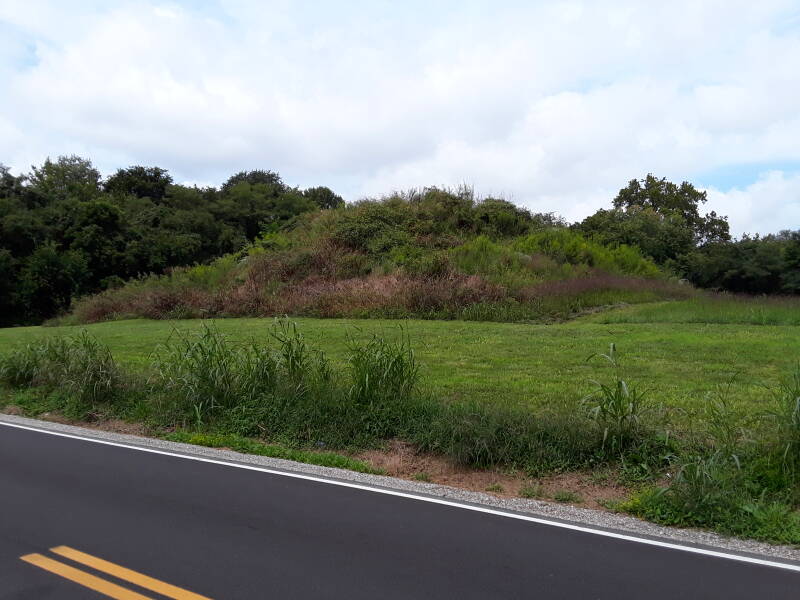
The Angel Mounds site is on the north shore of the Ohio. The town itself was built above the river's flood plain. The crop lands were subject to the annual spring floods which replenished soil nutrients. The farmland was adequate to allow the settlement to produce surplus crops, supporting trade and a higher population with artisans producing various crafts including pottery.
Maize (corn) was a primary crop. However, it lacks the amino acids lysine and tryptophan. Humans can't synthesize them, and must get them from diet in order to produce proteins, niacin, and the neurotransmitter serotonin. Beans added the needed amino acids. Not that the inhabitants understood the biochemical details, but they had figured out that a diet of maize alone wasn't adequate, while maize plus beans was OK. The residents also raised and ate squash, gourds, and sunflowers.
They used bone fishhooks and cord nets to catch catfish and drumfish, and they also collected mussels. They ate the mussels, and then burned and ground their shells to serve as a tempering agent in pottery. Mixing the mussel shell particles into the clay prevented it from shrinking and cracking during drying and firing. This technique seems to have been discovered around 800 CE. They didn't have the potter's wheel, their pottery was built up from strips of clay, then smoothed.
They also hunted deer, bison, rabbit, squirrel, turkey, and other game, and gathered nuts and fruits and berries.
The town covered about 40 hectares. It was surrounded by a palisade, a wall between 3.5 and 4 meters tall. It was built from a row of wooden posts sunk into holes in the ground. Then wattle and daub was applied — sticks loosely woven between the vertical poles, covered with a layer of mud and grass.
A section of the palisade has been recently reconstructed, with multiple bastions like the original. A defensive bastion protrudes outside an otherwise straight wall, providing a place from which to see and attack would-be attackers. The original bastions were 35–40 meters apart, protruding 3–3.5 meters out from the wall.
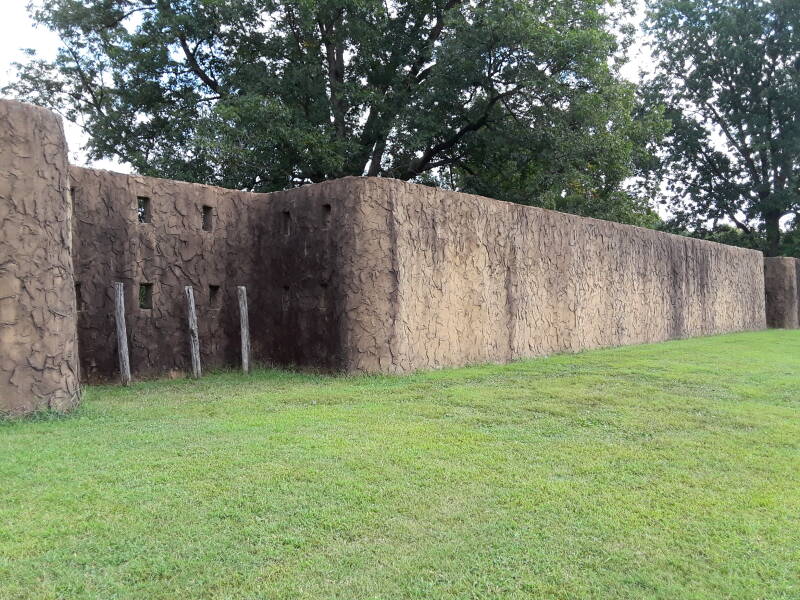
Another barrier, more of a fence, was built 4.3 meters outside the palisade wall.
A series of native groups had lived in this region for thousands of years. There is evidence for humans in Indiana as early as the Archaic stage of 8000–6000 BCE. These include hunting camps of the nomadic Clovis culture. The Early Woodland period of 1000 BCE to 200 CE produced the Adena Culture, which domesticated wild square and produced pottery, large cultural advances over the earlier Clovis culture.
Amazon
ASIN: 1598744518
The later Hopewell Culture was the first to establish permanent settlements in Indiana. Around 1 CE they were growing crops of sunflowers and squash. Around 200 CE they began to construct mounds which they used for burials and ceremonies. The Hopewell culture began to decline around 400 and had completely disappeared by 500, we don't know why.
The Mississippian Culture developed around 800 CE along the Mississippi river and its tributaries. It spread as far north as today's Saint Louis, Missouri, as far west as today's Oklahoma, and east to today's South Carolina. Its trade extended further — west to the Rocky Mountains, north to the Great Lakes, and east to the Atlantic Ocean. The Late Mississippi period of roughly 1400–1540 saw increased warfare and population movement. Mound building and public ceremonies were scaled back, with effort focused on defensive measures. Ceramic items became more plain over time. Almost all of the Mississippian settlements had been abandoned by 1539–1540, when Hernando de Soto led the first European expedition to the interior of today's U.S.
Amazon
ASIN: B00PIKPFWA
The Late Mississippian Caborn-Welborn culture developed further downstream along the Ohio, from where the Wabash river flows into the Ohio to where the Ohio flows into the Mississippi. Some archaeologists think that the Caborn-Welborn culture developed from the Angel Mounds people around 1400, and lasted to around 1700. The native people had no immunity to the many deadly diseases the Europeans carried, including smallpox and measles, and unknown but enormous numbers of them died. Trade spread the epidemics faster than the European carriers advanced.
The Mississippian people had a number of characteristic traits, including the construction of large earthwork pyramid mounds and platform mounds. Structures including homes, temples, and tombs were usually built on top of these mounds. Political and religious power was centralized, often in the hands of a single chief. A chiefdom based in a larger settlement controlled surrounding smaller settlements.
They worked naturally occurring copper deposits with hammering and annealing, but they practiced no smelting or other metallurgy with iron or bronze. They had no stone architecture and, as far as we know, no writing system. All of this makes it difficult to learn much about their society.
Below is Mound A or the Central Mound, the largest mound at Angel Mounds.
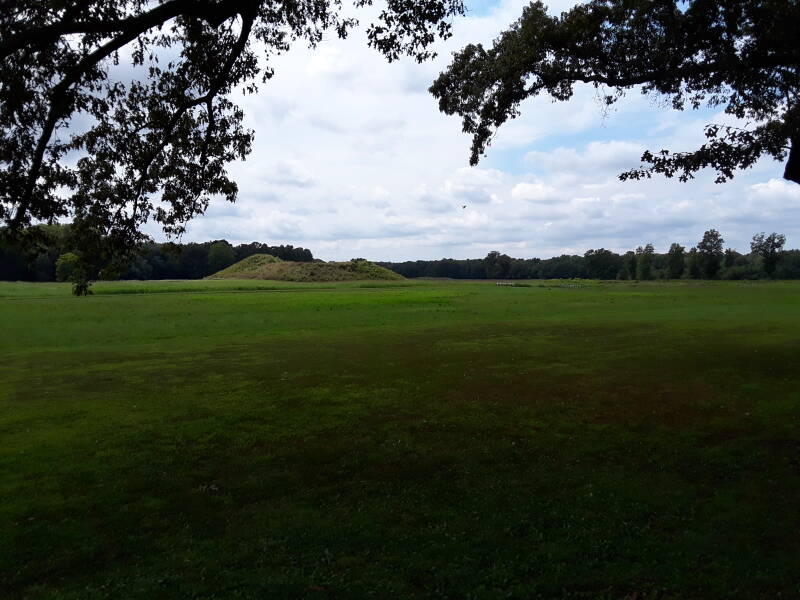
A large open plaza lies to the northeast of Mound A. This was an open space back then, possibly where rituals could have taken place, or maybe it was a market area. A similarly sized one was on the opposite side, to the southwest of Mound A.
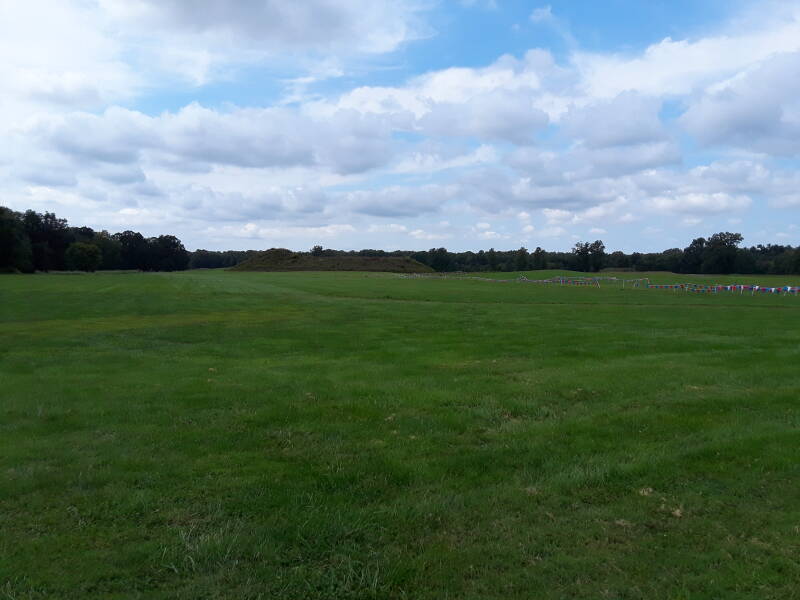
There are multiple paths you can follow around the site.
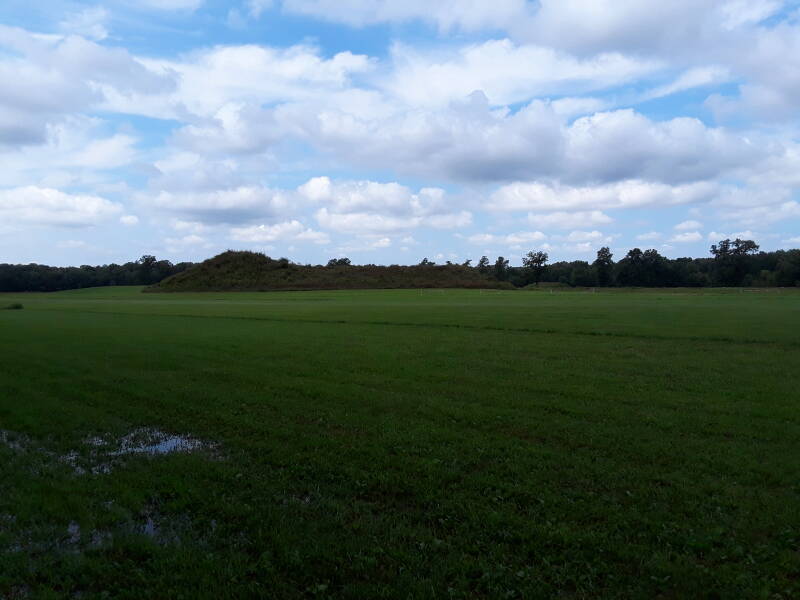
Below, we have circled Mound A and now we're approaching it from the southwest. It's the largest in the complex, standing 13 meters tall at its peak, 196 meters long, and 102 meters wide. This places it among the largest prehistoric structures in the eastern U.S. There are three distinct levels, with a small conical mound at the southeast corner of its upper level.

Almost all of the Mississippi Culture settlements had been abandoned before the Europeans arrived. Some Natchez settlements in the lower Mississippi valley were still occupied when De Soto's expedition encountered them in 1542. In the late 1600s the French were the next to encounter the Natchez.
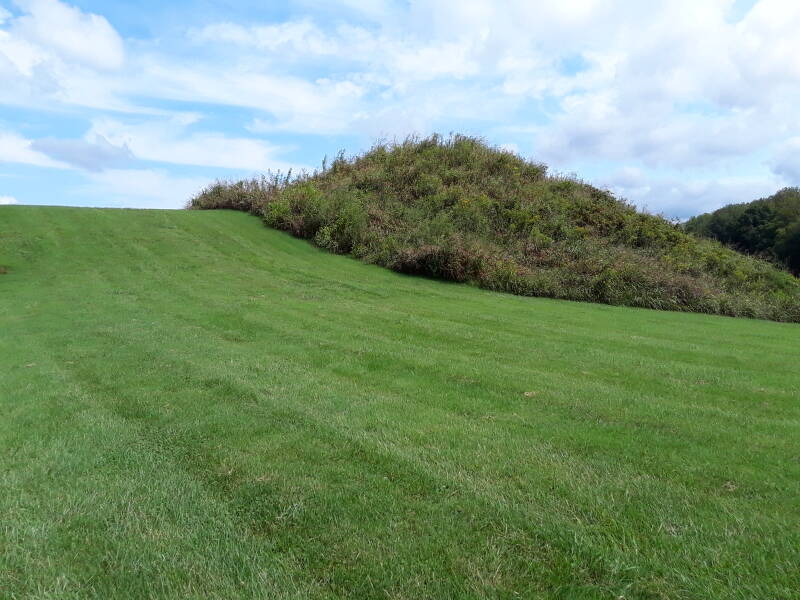
According to the Europeans who encountered these last Mississippian groups, the hereditary chief would probably live in a dwelling on the largest mound. Other upper-class people would have lived on other mounds. The rest of society lived in homes between the mounds, with their home size reflecting their place in the culture.
Below is the view to the northeast from the top of Mound A, looking across the large northeastern plaza.
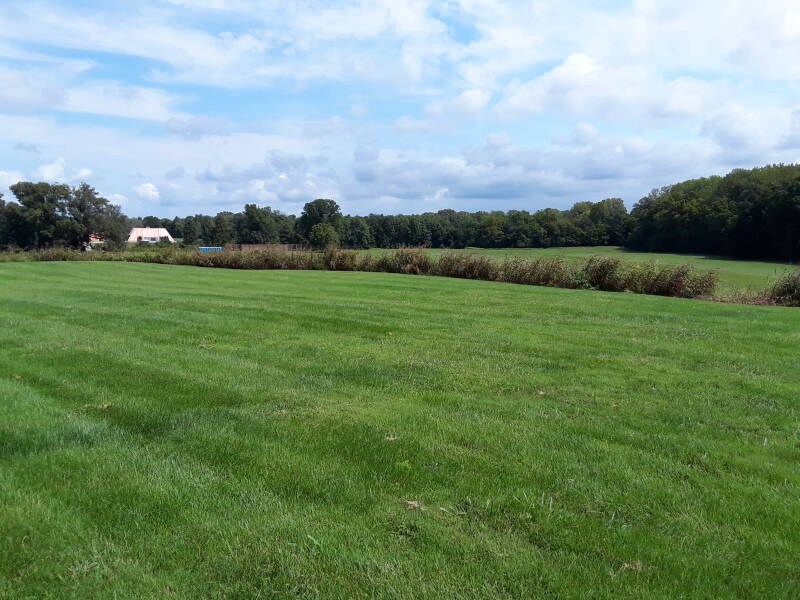
Below we've turned to look the opposite direction, from the top of Mound A to the southwest.

Mound F was to the southwest of Mound A. The area between Mound A and Mound F is believed to have been another open plaza.
Also known as Temple Mound, Mound F is the only mound that has been completely excavated. What you see today is a partial reconstruction.
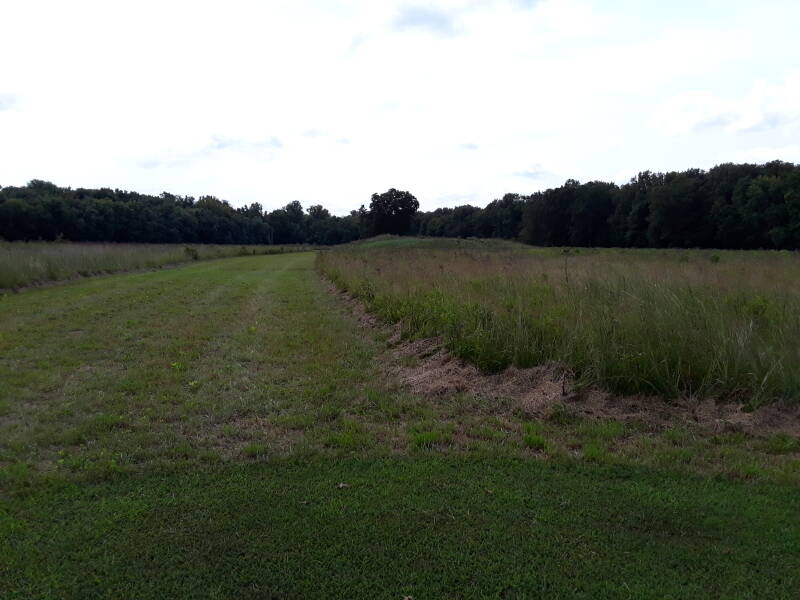
The Temple Mound was 73 by 72 meters in size, standing 4.26 meters tall. It was built in several phases. Initially there was a structure at the original ground level in the Temple Mound's location. That was removed as the first layer of the mound was built, and a new structure was built on top of that.
Then another mound layer was added, with more structures on top, these apparently domestic. Then yet another mound layer, with a large rectangular structure with at least two rooms, plus anterooms or porticoes added to it.
Then yet another layer of earth was added. This uppermost layer was heavily disturbed during historic times, so the archaeologists couldn't tell anything about what may have been on top of the final layer.

The Angel Mounds site was abandoned by around 1450. Some of the people had moved downstream along the Ohio, forming what is called the Caborn-Welborn Culture. It was centered around the area where the Wabash river joins the Ohio. That culture disappeared around 1700.
The Europeans brought epidemics of deadly diseases, and plainly genocidal policies. The Iroquois people named George Washington Conotocaurius or "Town Destroyer" for his deadly actions against the native people, a family tradition going back to similar actions by his great-grandfather in the late seventeenth century.
The Treaty of Paris ended the American War of Independence in 1783. Great Britain had ceded to the U.S. its claims to the territory between the Appalachian mountains and the Mississippi river. In 1787 the U.S. Congress passed the Northwest Ordinance, establishing guidelines for how the federal government would govern that territory. In April 1789, George Washington's U.S. Presidency began.
Washington's national policy depended on acquiring Native land. He hoped that offering them what the U.S. government saw as a fair price would allow the country to expand with minimal bloodshed. But if the tribes refused the offer, he felt that there was no choice but to wage war against them.
Many of the Native nations had allied with the British during the war, so the victorious Americans saw them as conquered enemies and used military threats, bribes, and alcohol to force chiefs to sign documents surrendering their people's land.
In 1790, Washington and Henry Knox, his Secretary of War, ordered a military force into the territory between the Ohio and Mississippi rivers, today's states of Ohio, Indiana, and Illinois, with orders to force the natives off their land, slaughtering them if necessary. "Extirpate" was the word Washington used.
By the 1820s and 1830s the U.S. was violating the terms of the treaties they had forced the Native nations to sign. Mass relocation and cultural disruption was underway. Oral traditions were lost.
Today we simply don't know which, if any, surviving Native people are the descendants of the inhabitants of Angel Mounds.